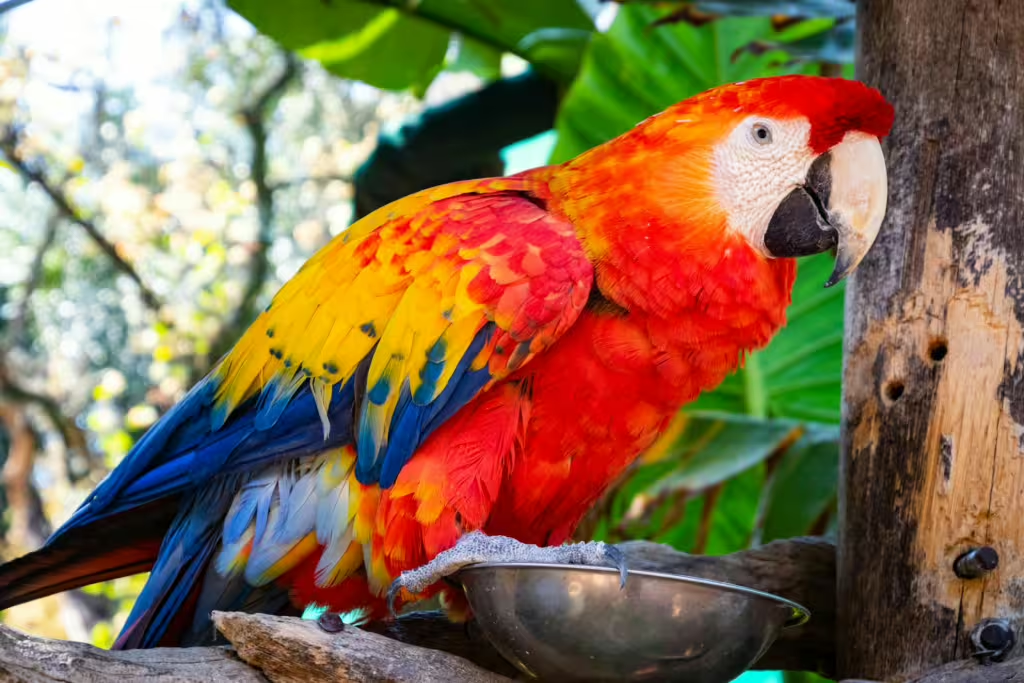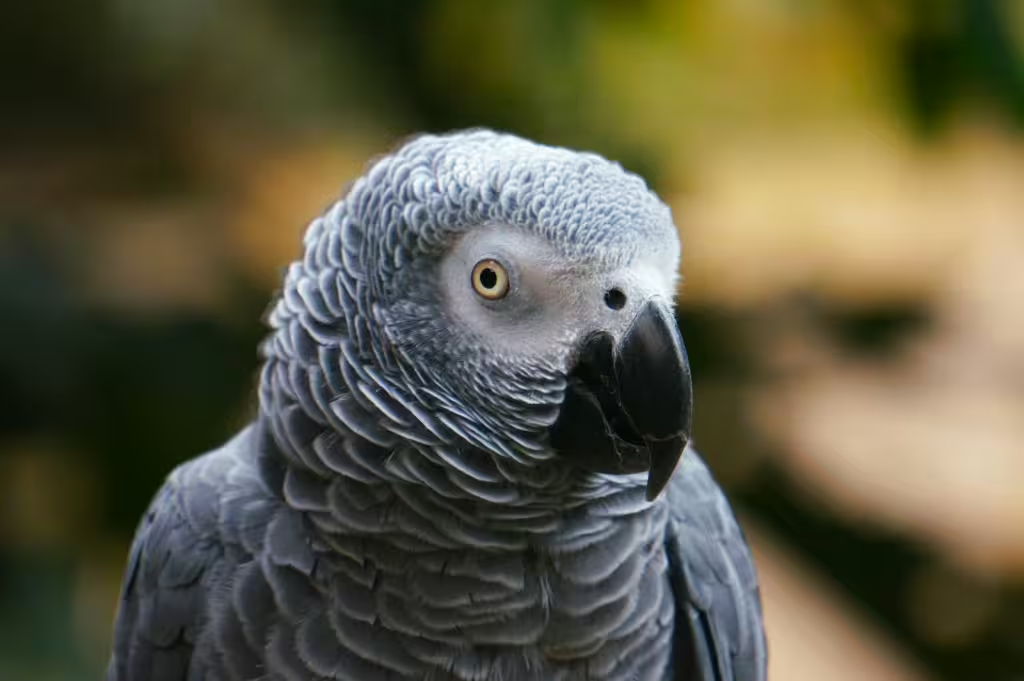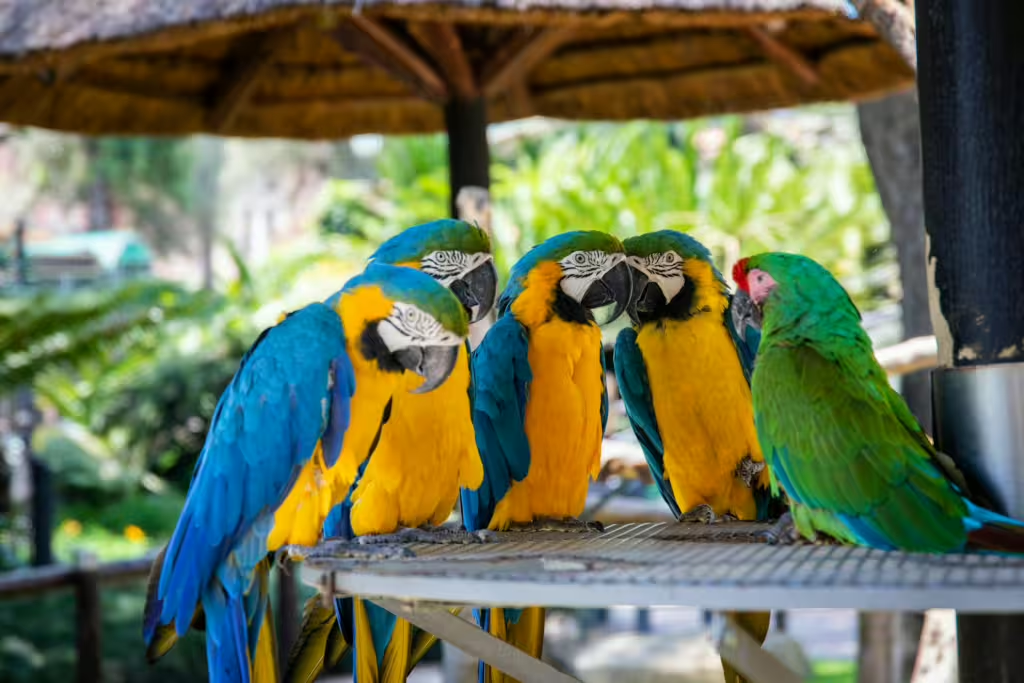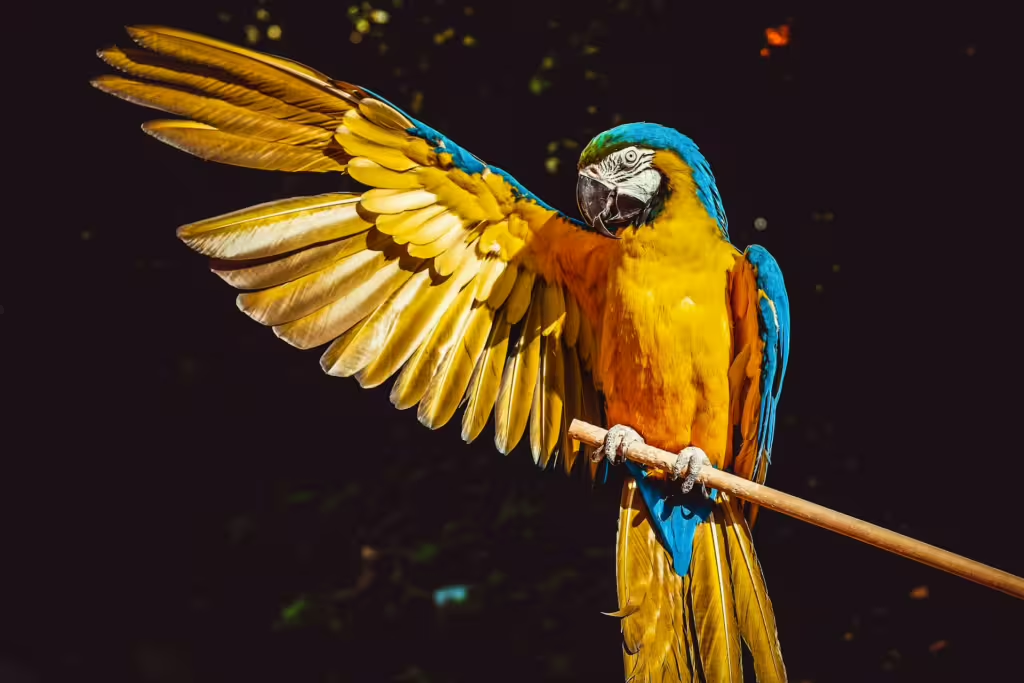Whether they are flying through the tropical skies of a distant rainforest or chatting away in the parlor of an eccentric grandparent, parrots are captivating creatures. Parrots are among the most intelligent animals in the animal kingdom, they possess their remarkable vocal abilities, striking personalities, and vibrant colors rivaled only by birds of paradise. For centuries, humans have had something of a fascination with parrots; we have brought them onto sailing ships with us, taught them hundreds of words in the English language, and even folded them into our living wills.
Found primarily in tropical and subtropical regions, parrots belong to the family Psittacidae, which includes over 400 separate species. These incredible birds are not only beautiful but also uncharacteristically intelligent, even by avian standards. Like corvids, however, parrots often demonstrating problem-solving skills, emotional depth, and social complexity that can be compared only to primates.
In this article, we will not only delve into the diverse species of parrots, we will highlight the many facets of their unique intelligence that sets them apart from other members of the animal kingdom. At the same time, we will explore the different characteristics that make them such extraordinary members of the avian world.
Diverse Species of Parrots
As with many members of the bird family, parrots can come in a variety of shapes, sizes, and colors, each adapted to their specific habitats. Below, we have listed some of the most notable species and what makes them unique.
African Grey Parrot (Psittacus erithacus)
The African grey parrot is widely regarded as one of the most intelligent bird species on the planet. This clever creature is most famous for its remarkable ability to mimic human speech, but more than that, certain specimens have shown themselves capable of understanding the context of the words they hear. In essence, this means that this bird is capable of speaking and understanding the English language, something very few other birds have shown the aptitude for. Native to the rainforests of West and Central Africa, this parrot can be categorized as a medium-sized bird, whereas many parrots are much larger or much smaller. The African grey has (unsurprisingly) a predominantly grey body, a striking red tail, and piercing yellow eyes.
In terms of raw intelligence, African greys have demonstrated cognitive abilities akin to that of q five-year-old human child; which is downright remarkable! They can understand concepts like color, shape, numbers and can even solve fairly complex puzzles. A famous African grey named Alex once revolutionized the scientific understanding of avian intelligence by proving that parrots could not only mimic words but also comprehend the meanings behind them.
Macaws

When one thinks of parrots, they are most likely thinking of macaws. These iconic birds are large, brightly colored and generally native to Central and South America. Macaws are known for their long tails and vibrant plumage, which differentiates them by name in most cases. For instance, species like the blue-and-yellow macaw (Ara ararauna) and scarlet macaw (Ara macao) are both very recognizable by even the most uneducated animal enthusiasts. This also means that they are popular when viewed in the wild and in captivity, either in zoos or as exotic pets.
Despite being found living uncommonly solitary lives in captivity, macaws are actually very social birds. In the wild, these large parrots live in flocks of between 10 to 30 individuals. They are skilled problem solvers, often observed using tools and navigating complex situations. This remarkable intelligence is further evidenced by their ability to bond deeply with their human caregivers, displaying empathy and affection for “animals” who are nothing like members of their own species.
Cockatoos
Another very iconic bird, cockatoos are both characterized and recognized by their expressive crests and white or black plumage. These parrots are native to Australia and its surrounding islands and can be nearly as intelligent as their African and South American cousins. Among the most intelligent breed of cockatoo is the Goffin’s cockatoo (Cacatua goffiniana), which is most known for its problem-solving skills.
Studies have shown that Goffin’s cockatoos can use tools to solve puzzles and problems. Moreover, these birds have even exhibited an understanding of cause-and-effect relationships; another unusual mental capacity for animals to possess. The playful nature and curiosity of these parrots often leads them to explore and manipulate their surroundings in unpredictable ways as well.
Budgerigars (Melopsittacus undulatus)
Also known as budgies or parakeets, these small parrots are native to Australia, but chances are good you’ve seen them flitting about the cages of your local pet store. Budgies are one of the most popular pet birds in the world. Despite their size relative to other parrots, budgies are highly intelligent and quite capable of learning hundreds of words and mimicking the sounds they hear. This surprising level of intelligence is often demonstrated through the birds’ ability to recognize patterns, form strong social bonds, and even learn tricks. Like macaws, these birds are also highly empathic and social, forming real emotional bonds with their human family members.
Amazon Parrots
Amazon parrots, native to the Americas, are known for their exceptional vocal abilities, as well as their singular and quite vibrant green plumage. The yellow-naped Amazon parrot (Amazona auropalliata) is particularly famous for its capacity to mimic human speech. Like the myna bird and the African greym this species mimics humans with incredible clarity, making it quite unique among even the best avian mimics. As is the case with most parrots, these birds thrive in social environments and have been observed engaging in cooperative tasks with other birds, showcasing the advanced problem-solving skills that Amazon parrots possess.
Kea (Nestor notabilis)
This is an unusual one, even by parrot standards. The kea, a mountain parrot from New Zealand, stands out among its Psittacidae fellows for its playful and mischievous nature. New Zealanders know it as the “clown of the mountains,” but all joking aside, the kea is one of the most intelligent bird species in the world. This is mostly due to the fact that kea parrots have an uncanny amount of problem-solving skills, as well as the ability to work collaboratively with other birds. They have been observed using tools, solving puzzles, and even engaging in playful behavior that suggests advanced cognitive abilities far beyond the normal bird brain.
Parrot Intelligence: What Sets Them Apart?
Advanced Problem-Solving Skills
We’ve already mentioned how several of the parrots on this list posses the unique ability to solve advanced problems and puzzles simply by “thinking it through.” Indeed, most parrots are renowned for their exceptional problem-solving abilities, which often rival those of even the most intelligent primates; including some human beings. These amazing birds display remarkable ingenuity when faced with challenges, often employing tools to fix the issue while seemingly understanding the complex sequences needed to solve problems.
Many species have been observed devising innovative strategies to achieve their goals. For instance, the kea of New Zealand has been observed solving multi-step puzzles to access food rewards. In controlled experiments, keas have demonstrated the ability to manipulate objects, remove obstacles, and even collaborate with other birds to achieve a shared goal. This understanding of cause and effect is rare in non mammalian creatures, and even rare amongst some of the more intelligent bird species.
African grey parrots also posses unique cognition. Research involving African greys has shown that they can comprehend abstract concepts such as color, shape, and number; this indicates a depth of understanding heretofore unseen in the vast majority of the animal kingdom. In one experiment, an African grey named Griffin was able to distinguish between objects of the same color but different shapes and vice versa, indicating a nuanced understanding of categorization.
Social Complexity
Parrots, like many birds, are highly social creatures. These birds thrive best in flocks that demand cooperation, communication, and a keen understanding of social dynamics. In fact, living in such intricate social structures requires a measure of advanced intelligence that other creatures simply cannot achieve. This allows parrots to navigate relationships, establish hierarchies, and maintain group cohesion. In addition, the wide range of vocalizations, body language, and even tactile interactions that parrots evince, such as mutual preening, can be used to communicate with and strengthen bonds within their flock.
Social interactions among parrots can be surprisingly complex; more so than in many human beings, in some case. Take, for instance, the macaw, which forms lifelong pair bonds with their paramours. These pairs exhibit a rare degree of loyalty and teamwork in raising their young. Flocks of parrots can communicate with eachother to forage for food, find shelter, avoid predators, and ensure their continued survival via maintaining social cohesion, cooperation, and mutual support.
Vocal Mimicry and Communication
One of the most fascinating traits of parrots lies in their singular ability to mimic sounds, including human speech. It must be noted that this skill is not merely a parlor trick to be used by pet owners to entertain their guests. It is, in fact, deeply rooted in the birds’ natural communication systems. In the wild, parrots use this uncanny vocal ability to convey a wide array of complex messages, such as alerting their flock to danger, signaling food sources, expressing affection, or maintaining contact while flying. At this point, their remarkable mimicry of human speech is merely an extension of this innate adaptability. It showcases the parrots’ capacity to learn and replicate a wide range of sounds.
African grey parrots are interesting because they can understand the context of the sounds they mimic. They are not just repeating things back but expressing them in a meaningful way, in order to indicate some manner of intention on the part of the parrot. A parrot might say “hello,” for instance, when someone enters the room or they might even ask for a specific treat or favorite toy by name. This ability to associate words with objects or actions reflects a level of cognitive sophistication that goes beyond rote repetition.
Emotional Intelligence

Despite the fact that they are animals, parrots are deeply emotional creatures. These birds are just as capable of forming strong bonds with both their flock members and human caregivers as a dog or a primate. This emotional intelligence is evident in their ability to recognize and respond to the feelings of others. For instance, a particularly empathic parrot might sense when their owners are upset and may offer comfort by nuzzling or vocalizing softly. This empathetic behavior is a testament to the parrots’ ability to perceive and react to emotional cues.
In their natural habitats and even in captivity, parrots have been known to display a range of emotional behaviors, from joy and playfulness to grief and mourning. Flock members often console each other after the loss of a mate or offspring, demonstrating a depth of emotional connection that other animals might not evince. This advanced emotion also manifests as play behavior, which many other animals don’t really engage in. Nevertheless, the innate playfulness of parrots is a sure sign of cognitive complexity, as well as an expression of their vibrant emotional capacity.
Memory and Learning
In addition to being able to mimic a wide array of sounds and words they hear, parrots possess extraordinary memory capabilities. In the wild, this memory is vital for their survival, because they rely on it to locate food sources, remember migration routes, and identify safe nesting sites. In this case, the memory is a sort of spatial awareness and a degree of recall that enables them to thrive in diverse and often challenging environments.
Parrots also learn from their experiences, quickly adapting to new situations as they come. They learn from both observation and trial-and-error. In captivity, some parrots have learned how to manipulate locks or open cages after observing their surroundings and/or the repetitive action of their caregivers. This ability to learn and apply knowledge demonstrates an impressive, almost supernatural problem-solving acumen and adaptability.
Parrots also have a capacity for social learning, picking up behaviors and vocalizations from their flock or human caregivers, which allows them to integrate into new social groups and adapt their communication to suit different contexts. Over time, their ability to learn and remember fosters a deep bond with their human companions. After many years, they may even learn to recognize and respond to specific cues, routines, and preferences of their owners, family friends, or even other household pets.

True Investigator Says…
As you can see, parrots are some of the most fascinating and intelligent birds in the entire world. The more we learn and understand about the intelligence of parrots, the more we can learn about the very nature of intellect, memory, social dynamics, and empathy. That said, we must do what we can to continue to protect and support these incredible birds. Remember, parrots are more than just colorful birds—they are sentient beings with rich emotional lives and extraordinary cognitive abilities; they deserve our respect and our help.
Discover more from TrueInvestigator
Subscribe to get the latest posts sent to your email.


